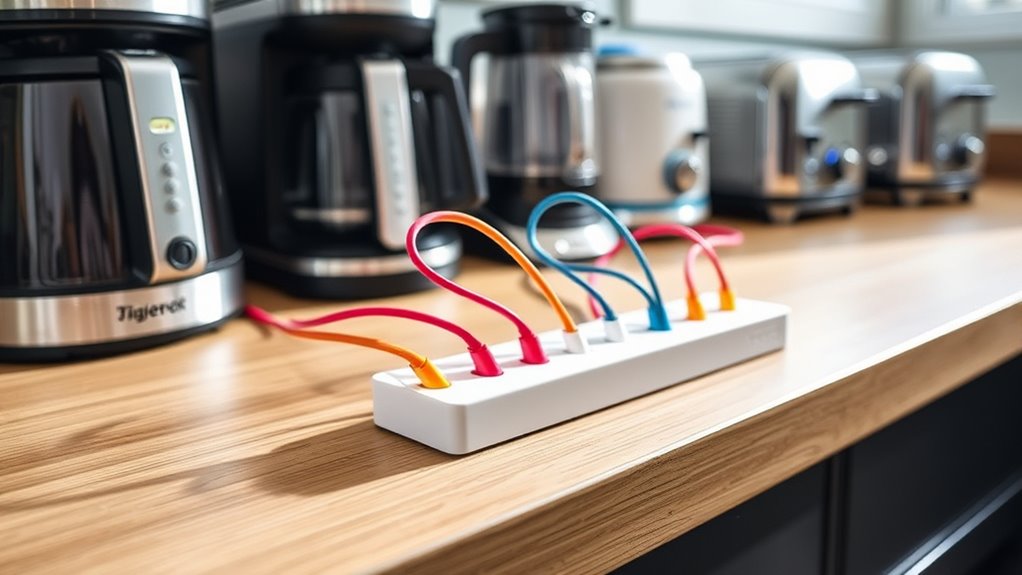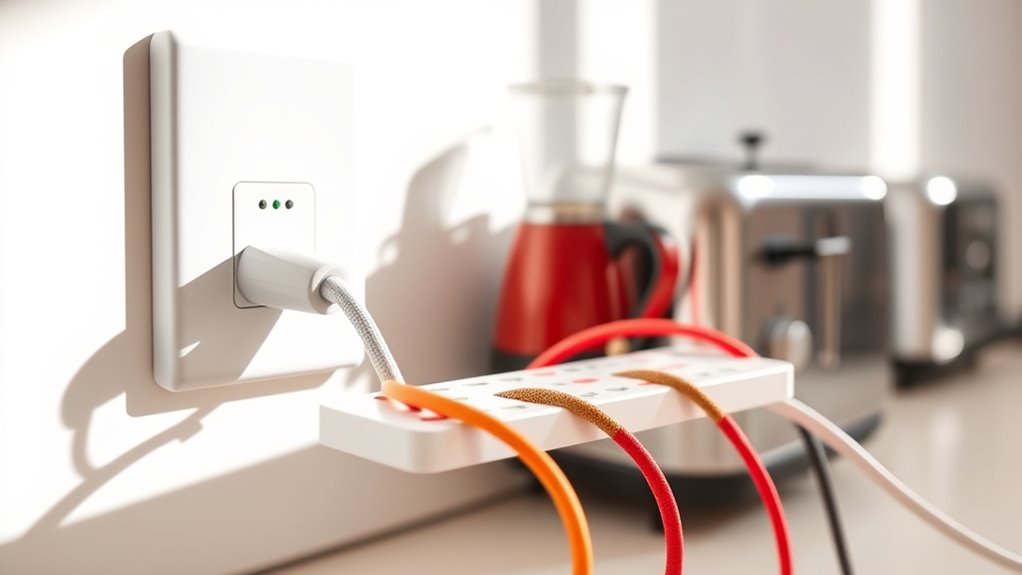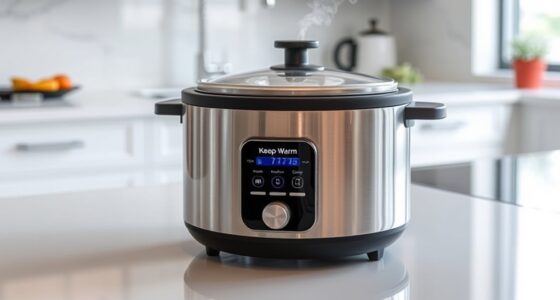To protect your small appliances from power surges, use surge protectors with high joule ratings and built-in indicator lights to confirm their functionality. Combine these with noise filters, especially for sensitive electronics, and avoid daisy-chaining multiple strips. Regularly inspect and replace devices that lose protection. Staying informed about the best tools and practices helps keep your appliances safe, and exploring further provides even more tips to shield your valuables effectively.
Key Takeaways
- Use surge protectors with high joule ratings to safeguard small appliances from voltage spikes.
- Regularly check surge protection indicator lights and replace devices when protection fails.
- Combine noise filters with surge protectors for enhanced shielding against electrical noise and transient surges.
- Avoid daisy-chaining multiple power strips to prevent overload and ensure effective surge protection.
- Incorporate AI-based systems for real-time detection and response to abnormal electrical surges.

Power surges can happen unexpectedly, and they pose a significant risk to your small appliances. These sudden spikes in electrical voltage can damage devices like your laptop, blender, or smartphone chargers, leading to costly repairs or replacements. To protect your valuables, you need to understand how to shield them effectively from these unpredictable events. One practical step is to use noise filters and power strips designed with surge protection features. Noise filters help eliminate electrical noise and transient voltage spikes that can harm sensitive electronics, ensuring a cleaner, more stable power supply. When combined with a high-quality power strip equipped with surge protection, these tools create a barrier that prevents harmful voltage surges from reaching your appliances.
Protect your small appliances with surge-protected power strips and noise filters for safer, more stable power.
Power strips are essential because they allow you to connect multiple devices to a single outlet, reducing the clutter of cords and making it easier to manage your electronic setup. Many power strips come with built-in surge protectors, which act as a first line of defense. They monitor the incoming voltage and divert excess energy away from your devices when a surge occurs. Look for power strips with a joule rating—this indicates how much energy they can absorb before failing. The higher the rating, the better the protection. Also, ensure your power strip has a reliable indicator light that confirms surge protection is active. If the indicator turns off or the strip stops working, it’s a sign that the device has absorbed a surge and needs replacing.
Incorporating noise filters into your setup further enhances protection. Noise filters are often built into power strips or can be purchased separately. They work by filtering out electrical interference and transient spikes, which can cause your small appliances to malfunction or sustain damage over time. Using noise filters is especially important if you notice your devices flickering or experiencing inconsistent performance. These filters help create a more stable power environment, reducing the risk of damage from minor surges or electrical noise that often accompanies thunderstorms, power outages, or unstable wiring. Additionally, utilizing AI-based security in your electrical systems can help detect and respond to abnormal surges more quickly, minimizing potential damage.
Ultimately, combining noise filters with surge-protected power strips provides a thorough solution. It’s a proactive way to safeguard your small appliances from the unpredictable nature of electrical surges. Remember to regularly check your power strips, replace them when their surge protection indicator fails, and avoid daisy-chaining multiple strips, which can overload the system. By doing so, you’re taking a simple but effective step to extend the life of your appliances and keep your home safe from electrical damage.
Frequently Asked Questions
Can Surge Protectors Be Used Outdoors Safely?
Yes, you can use surge protectors outdoors safely if they have outdoor durability and weather resistance. Look for models specifically designed for outdoor use, with features like waterproof enclosures and UV-resistant materials. These safeguard your small appliances from power surges while standing up to rain, sun, and other weather conditions. Always follow the manufacturer’s instructions to guarantee proper installation and safety, so your outdoor appliances stay protected.
How Often Should I Replace My Surge Protector?
You should replace your surge protector every three to five years, but it depends on your replacement schedule and lifespan considerations. Surge protectors can wear out over time, especially after power surges or lightning strikes, which may compromise protection. Regularly inspect for damage or worn-out components, and follow manufacturer recommendations. Staying proactive ensures your small appliances stay protected, and replacing your surge protector at the right intervals maximizes its effectiveness.
Do All Small Appliances Need Surge Protection?
Not all small appliances need surge protection, but many do, especially those with sensitive electronics. Check appliance compatibility first—some devices are more vulnerable to power surges. Use the right surge protector type, like a basic surge strip for less sensitive items, or a more advanced protector for electronics such as laptops or smart gadgets. Protecting your appliances helps prevent damage and extends their lifespan.
Is There a Difference Between Surge Protectors and Power Strips?
Think of surge protectors and power strips like a sturdy shield versus a simple extension cord. Surge protectors have ratings that indicate how well they guard against voltage spikes, ensuring your small appliances stay safe. Power strip safety doesn’t necessarily include surge protection, so appliances plugged into a basic strip risk damage. Always check the surge protector ratings before use, and don’t mistake a regular power strip for a protective device.
Can Surge Protectors Prevent Damage From Lightning Strikes?
Surge protectors can help prevent damage from lightning strikes, but their effectiveness depends on their surge protector capacity. During a lightning strike, a surge protector absorbs excess energy, protecting your small appliances. However, if the surge exceeds the protector’s capacity, damage may still occur. To maximize protection, choose a surge protector rated for high energy absorption and consider unplugging devices during thunderstorms for added safety.
Conclusion
By now, you see how crucial surge protection is for your small appliances. Protecting your devices saves you money and hassle, giving you peace of mind. Are you willing to risk damage or data loss just because you didn’t take a simple step? Investing in surge protectors isn’t just smart—it’s essential for safeguarding your home and your peace of mind. Don’t wait until it’s too late; secure your appliances today.









